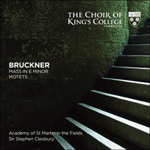
Welcome to Hyperion Records, an independent British classical label devoted to presenting high-quality recordings of music of all styles and from all periods from the twelfth century to the twenty-first.
Hyperion offers both CDs, and downloads in a number of formats. The site is also available in several languages.
Please use the dropdown buttons to set your preferred options, or use the checkbox to accept the defaults.

from notes by Martin Ennis © 2020
 Brahms & Bruckner: Motets Brahms & Bruckner: MotetsAward-winning choir Tenebrae performs a sumptuous selection of motets by Johannes Brahms and Anton Bruckner. A portion of the proceeds from sales of this recording will be donated to Macmillan Cancer Support.» More |
 Bruckner: Mass in E minor & motets Bruckner: Mass in E minor & motetsBruckner’s E minor Mass and a selection of his profoundly beautiful motets were selected by Sir Stephen Cleobury as his last album at King’s, recorded only a few months before his death. Perhaps the deepest and most spiritual of Bruckner’s Masses, ...» More |

